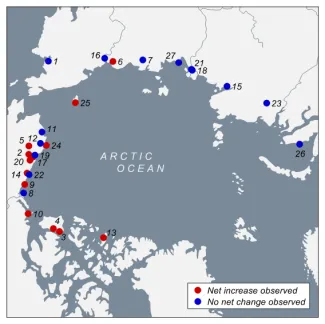One of the most conspicuous signals of climate change in high-latitude tundra is the expansion of thermokarst pools. These small but abundant water features form rapidly in depressions caused by the melting of ice wedges (i.e., meter-scale bodies of ice embedded within the top of the permafrost). Pool expansion not only signals permafrost degradation, but strongly impacts subsequent thaw rates through a series of complex positive and negative feedbacks which play out over timescales of decades, the net effect of which may accelerate carbon release from the underlying sediments. Despite the importance of thermokarst pool expansion to assessments of contemporary permafrost thaw, historical observations are limited in spatial and temporal frequency. Here we present the most geographically extensive and temporally dense measurements of recent expansion yet compiled, in which changes to pool extent from 2008—2020 were quantified through satellite-imagery analysis at twenty-seven landscapes dispersed throughout the circumpolar tundra. The results revealed instances of rapid thermokarst pool expansion at 44% of survey areas, in temperature settings that ranged from mild to very cold. The sites that experienced the greatest net change tended to be those with the greatest topographic relief (tens of meters of variation within an area of eight square kilometers). This pan-Arctic relationship was associated with an enhanced vulnerability of ice wedges near hilltops, as within most sites, the fastest growing pools were found on convex points on the land surface. These findings indicate the necessity of including topographic controls in global projections of permafrost thaw.
For more information, please contact:
Chuck Abolt
cabolt@lanl.gov

